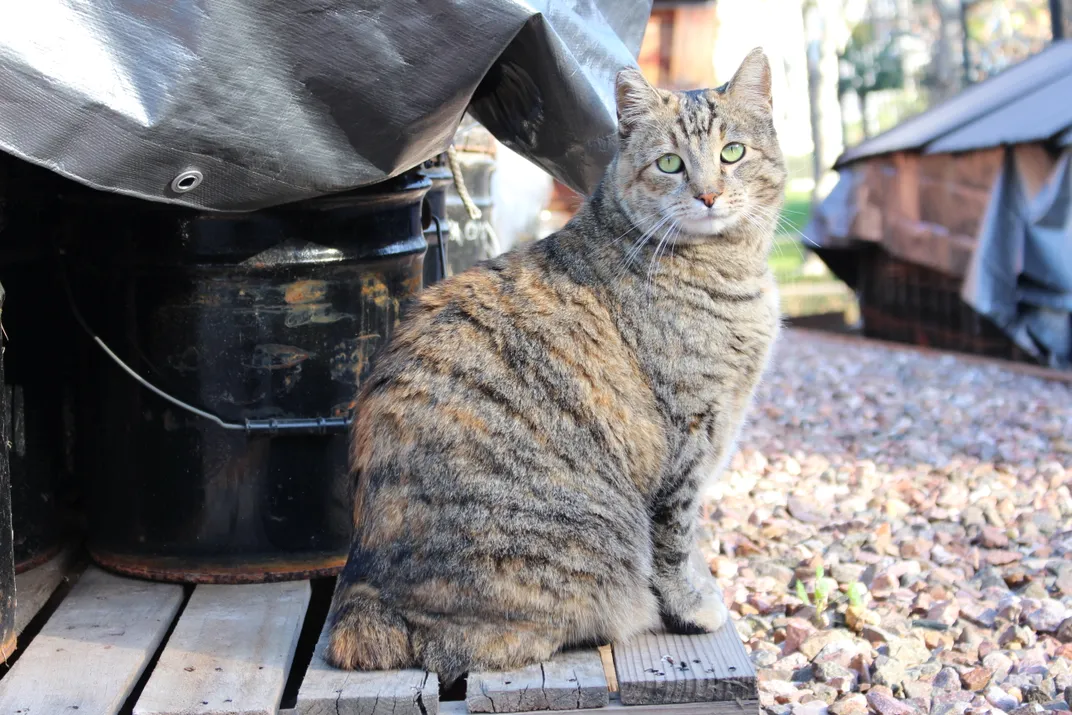These Paleo Pets Made Fossil Hunting Less Lonely
In the solitary hunt for bones, furry companions provide company, act as field assistants and sometimes even make the ultimate sacrifice
:focal(444x168:445x169)/https://tf-cmsv2-smithsonianmag-media.s3.amazonaws.com/filer/f0/0b/f00bea57-ddf9-4a82-a7b8-db3a5b66c760/800px-mary_anning_painting.jpg)
Picture a paleontologist on the hunt for the next big fossil find. More likely than not, it’s an intrepid, lone explorer staving off heat exhaustion as they search the ground. Yet, since the dawn of their discipline, paleontologists have been bringing their furry companions out into the rocky outcrops where prehistoric wonders rest. Animal assistants have been accompanying fossil hunters for nearly 200 years.
The most famous rockhound of all was one of the first. Tray, a mutt of a terrier sort, was the loyal friend of early 19th century paleontologist Mary Anning. Fossil lore says that Anning was the inspiration for the rhyme “She sells seashells by the seashore” but, regardless of whether that’s true or not, Anning made a reputation for herself as a skilled field expert with a sharp eye for strange marine reptiles eroding out of the Jurassic stone on England’s southern coast.
Tray followed Anning on her shoreline expeditions, and even helped out as a field assistant. When Anning would temporarily leave a find to go get help digging it out, Tray would stay behind, marking the place where the fossil rested. But the cliffs of England’s Jurassic Coast are treacherous. Piles of rock frequently calve off the rock walls to crash onto the beach below, and that is how, one day in 1833, Tray met his early demise. Anning continued her work for over a decade more, but there was no replacing Tray.
Anning wasn’t the only paleontologist to work with canine colleagues. Mary Leakey, another paleontology pioneer, also loved her dogs. Dalmatians were her favorite, and her pups often accompanied her into the field. In fact, Leakey’s dalmatians were trotting along with her on July 17, 1959, when she stumbled upon the skull of an early human that would go by various names such as Zinj, Dear Boy and Nutcracker Man before getting the permanent title Paranthropus boisei. There was a practical reason for the dogs to be along for the scientifically significant stroll. Eastern Africa has a greater array of potentially dangerous wildlife—think lions and venomous snakes—than other boneyards, so the dogs were an early warning system as well as beloved family members.
In the decades since Tray padded along the Charmouth beaches and Leakey’s dalmations romped through Olduvai, other paleo pets have accompanied their humans into the field. Dogs, eager to maintain their reputation as a paleontologist’s best friend, often follow their human friends to remote places. My German shepherd Jet recently accompanied me out to the 48-million-year-old rock of Wyoming, keeping me company and boosting camp morale as the field crew searched for mammals from before dogs even came on the evolutionary scene. From excavations of massive blocks of dinosaur fossils to explorations of Ice Age caves, I’ve met Laika, Pickles and plenty of other helpful canines.

Sometimes paleontologists meet new companions out in the field. “We had a feral dog become part of our camp in Mongolia, keeping the other feral dogs at bay,” says Western University of Health Sciences paleontologist Brian Kraatz. The dog was so attached to the field crew that she followed them to the next field camp, over 18 miles away. Meredith Rivin of the Burke Museum had a similar experience with a pitbull on a mitigation project in California. At first, the dog made Rivin and the construction crew nervous. “She had a lot of scars, cropped ears, and was just generally mean looking,” Riven says. “I shared a bit of my sandwich with the dog, and she instantly became a wiggly mess and my best friend for the rest of the project.”
Even wild animals can give paleontologists a hand, intentionally or not. Porcupines, leopards, and owls, for example, have often stashed bones in caves, preserving them for paleontologists to find. More directly, animals have helped researchers spots fossils on the ground—like a chicken that reportedly tipped off paleontologists to a large mammoth fossil in Nebraska by pecking at bones peeking out of the ground. And who could forget Billy the hyena? He was the pet and study subject of 19th-century geologist William Buckland, who used the tooth marks the young spotted hyena left on ox bones to help make the case that England’s Kirkdale Cave had once been the den of Billy’s Ice Age relatives. (Taking a page from Buckland’s book, Hagerman Fossil Beds National Monument paleontologist Kari Prassack that she’s had some camp dogs help her out with studying how carnivores modify bones, too.)
Then there’s Bob. While cats typically shy away from running around in the harsh desert sun, there is one feline that continues to earn her keep at the La Brea asphalt seeps in Los Angeles, California. Bob—named after the tailless bobcat, because she has had her tail surgically removed for health reasons—rests and stalks and nuzzles the paleontologists excavating immense tree boxes full of Ice Age fossils near the museum, earning her keep by controlling the local rodent population. While she hasn’t made any major finds herself yet, this modern cousin of Smilodon is a reminder that cats still rule La Brea.
/https://tf-cmsv2-smithsonianmag-media.s3.amazonaws.com/accounts/headshot/RileyBlack.png)
/https://tf-cmsv2-smithsonianmag-media.s3.amazonaws.com/accounts/headshot/RileyBlack.png)